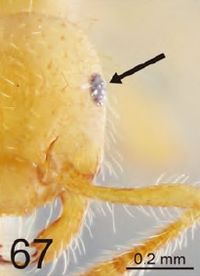Crematogaster ocellata
| Crematogaster ocellata | |
|---|---|

| |
| Scientific classification | |
| Kingdom: | Animalia |
| Phylum: | Arthropoda |
| Class: | Insecta |
| Order: | Hymenoptera |
| Family: | Formicidae |
| Subfamily: | Myrmicinae |
| Tribe: | Crematogastrini |
| Genus: | Crematogaster |
| Species group: | biroi |
| Species: | C. ocellata |
| Binomial name | |
| Crematogaster ocellata Hosoishi & Ogata, 2016 | |
Nothing is known about the biology of Crematogaster ocellata.
Identification
A member of the Crematogaster biroi group.
Keys including this Species
Distribution
North Vietnam
Distribution based on Regional Taxon Lists
Oriental Region: Vietnam (type locality).
Distribution based on AntMaps
Distribution based on AntWeb specimens
Check data from AntWeb
Countries Occupied
| Number of countries occupied by this species based on AntWiki Regional Taxon Lists. In general, fewer countries occupied indicates a narrower range, while more countries indicates a more widespread species. |

|
Estimated Abundance
| Relative abundance based on number of AntMaps records per species (this species within the purple bar). Fewer records (to the left) indicates a less abundant/encountered species while more records (to the right) indicates more abundant/encountered species. |

|
Biology
Castes
Nomenclature
The following information is derived from Barry Bolton's Online Catalogue of the Ants of the World.
- ocellata. Crematogaster ocellata Hosoishi & Ogata, 2016a: 590, fig. 111 (w.) VIETNAM.
- Type-material: holotype worker, 3 paratype workers.
- Type-locality: holotype Vietnam: Hoa Binh Prov., Mai Chau Dist., Tu Lung, 20°44’S, 104°56’E, 27.xi.1999, (15 min. TUS) (K. Ogata); paratypes wth same data.
- Type-depositories: IEHV (holotype); CASC, KUEC, TNHM (paratypes).
- Distribution: Vietnam.
Unless otherwise noted the text for the remainder of this section is reported from the publication that includes the original description.
Description
Worker
(n=4) HW 0.50–0.56; HL 0.53–0.59; CI 94–96; SL 0.40–0.45; SI 78–84; EL 0.07–0.08; PW 0.31–0.37; WL 0.58–0.66; PSL 0.08–0.10; PtL 0.18–0.22; PtW 0.16–0.18; PtH 0.12–0.15; PpL 0.12–0.13; PpW 0.17–0.18; PtHI 63–78; PtWI 81–85; PpWI 138–142; WI 100–106.
Workers monomorphic. Head subquadratic in full-face view. Mandibles with four teeth arranged at an equal distance, apical and subapical teeth large, basal two teeth smaller. Anterior clypeal margin convex in medial portion. Compound eyes not projecting beyond lateral margins of head in full-face view. Scapes reaching posterolateral corners of head.
Pronotal collar with almost straight anterior margin in dorsal view, distinctly lower than pronotum in lateral view. Pronotal dorsum without ridges laterally. Mesonotal dorsum with lateral ridges that irregularly extend posteriad to tips of propodeal spines. Pronotum and mesonotum in lateral view forming slightly convex, continuous dorsal outline. Metanotal groove in dorsal view transverse, almost straight in median portion, forming deep concavity that is laterally margined by lamellate ridges. Propodeal spiracles oval, situated at posterolateral corners of propodeum, touching metapleural gland bullae. Propodeal spines developed, longer than diameter of propodeal spiracles, in dorsal view directed posteriad.
Petiole in dorsal view with subparallel sides and narrow anteriorly, longer than wide. Posterior portion of petiole with short process that is slightly higher than posterior margin of petiole disc in lateral view. Subpetiolar process weakly developed as blunt process. Postpetiole in lateral view with weakly convex dorsum, as high as petiole, in dorsal view as wide as petiole, globular, not bilobed. Subpostpetiolar process developed as blunt process.
Integument essentially smooth and shining. Dorsal surface of head generally smooth and shining, but weakly with rugulae on surrounding region of antennal sockets. Mandibles with feeble rugulae and smooth interspaces. Clypeus generally smooth and shining, but with one distinct pair of longitudinal rugulae; rugulae not extending to posterior clypeal margin. Anterolateral shoulders of pronotum with feeble rugulae. Dorsal surface of pronotum smooth and shining. Lateral surface of pronotum generally smooth and shining, but with longitudinal rugulae on higher portion extending to mesopleura and lateral sides of propodeum. Mesopleura sculptured. Rugula on higher portion of mesopleura extending to small pit of mesothoracic spiracles. One pair of rugulae running from metanotal groove to tips of propodeal spines. Dorsal surface of propodeum weakly sculptured. Dorsal surface of petiole smooth and shining. Lateral surface of petiole sculptured. Dorsal surface of postpetiole smooth and shining. Lateral surface of postpetiole weakly sculptured posteriorly.
Standing pilosity sparse. Dorsal face of head with erect to suberect and stout long setae sparsely. Clypeus with two pairs of long setae in anterior portion, one directed upward and the other downward. Anterior clypeal margin with one pair of long setae medially and some pairs of short setae laterally. Scapes with suberect setae. Mesosoma with five pairs of long erect and stout setae (ps1PN, ps2PN, psaMN, pspMN, and ps1PS) that are much longer than other erect setae. Posterolateral tubercles of petiole posteriorly with two pairs of stout long setae. Postpetiole with five pairs of long setae on disc anterodorsally, anterolaterally and posteriorly. Fourth abdominal tergite with erect and stout suberect long setae sparsely, and short decumbent setae sparsely.
Body yellow. All flagellar segments yellow.
MISC In the worker this species is distinct among the Crematogaster biroi group in having reduced compound eyes (with c. 12–15 ommatidia).
Type Material
Hosoishi and Ogata (2016) - Holotype worker. Tu Lung, Mai Chau Dist., Hoa Binh Prov., VIETNAM, S 20 44 E 104 56, 27.xi.1999 (15 min TUS) (K. Ogata) (Entomological Collection of the Institute of Ecology and Biological Resources). Paratypes. Three workers same data as holotype (California Academy of Sciences, Entomological Laboratory and Institute of Tropical Agriculture, Faculty of Agriculture, Kyushu University, Natural History Museum of the National Science Museum).
Etymology
The specific name refers to the small compound eyes.
Determination Clarifications
This species corresponds to sp. eg-12 by Eguchi, Bui & Yamane (2011).
References
References based on Global Ant Biodiversity Informatics
- Hosoichi S., and K. Ogata. 2016. Systematics and biogeography of the ant genus Crematogaster Lund subgenus Orthocrema Santschi in Asia (Hymenoptera: Formicidae). Zoological Journal of the Linnean Society 176: 547–606.
